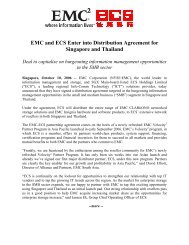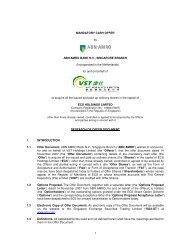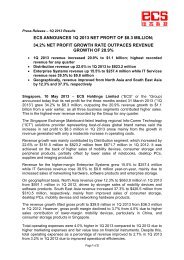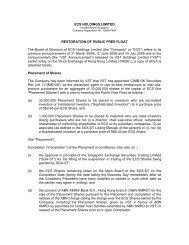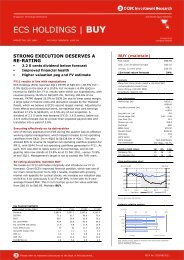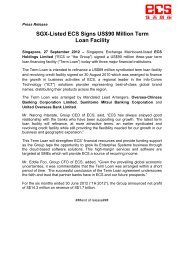Strength & Stability - ECS Holdings Limited
Strength & Stability - ECS Holdings Limited
Strength & Stability - ECS Holdings Limited
You also want an ePaper? Increase the reach of your titles
YUMPU automatically turns print PDFs into web optimized ePapers that Google loves.
2 Summary of Significant Accounting Policies (Cont’D)<br />
2.6 Financial Instruments (Cont’d)<br />
Non-derivative financial instruments (Cont’d)<br />
Cash and cash equivalents comprise cash balances and bank deposits. Bank overdrafts that are repayable on demand and that form<br />
an integral part of the Group’s cash management are included as a component of cash and cash equivalents for the purpose of the<br />
statement of cash flows.<br />
Available-for-sale financial assets<br />
The Group’s investments in equity securities are classified as available-for-sale financial assets. Subsequent to initial recognition, they<br />
are measured at fair value and changes therein, other than for impairment losses and foreign exchange gains and losses on availablefor-sale<br />
monetary items (see note 2.3), are recognised directly in equity. When an investment is derecognised, the cumulative gain or<br />
loss in equity is transferred to the income statement.<br />
Equity securities available-for-sale which do not have a quoted market price in an active market and whose fair value cannot be<br />
reliably measured are stated at cost less impairment losses which, in the opinion of the directors, are other than temporary.<br />
Others<br />
Other non-derivative financial instruments are measured at amortised cost using the effective interest method, less any impairment<br />
losses.<br />
Derivative financial instruments and hedging activities<br />
The Group holds derivative financial instruments to hedge its foreign currency and interest rate risk exposures. Embedded derivatives<br />
are separated from the host contract and accounted for separately if the economic characteristics and risks of the host contract and<br />
the embedded derivates are not closely related, a separate instrument with the same terms as the embedded derivative would meet the<br />
definition of a derivative, and the combined instrument is not measured at fair value through profit or loss.<br />
Derivative financial instruments are recognised initially at fair value; attributable transaction costs are recognised in the income<br />
statement when incurred. Subsequent to initial recognition, derivative financial instruments are measured at fair value. The gain or<br />
loss on remeasurement to fair value is recognised immediately in the income statement. However, where derivatives qualify for hedge<br />
accounting, recognition of any resultant gain or loss depends on the nature of the item being hedged as described below.<br />
The fair value of interest rate swaps is the estimated amount that the Group would receive or pay to terminate the swap at the balance<br />
sheet date, taking into account current interest rates and the current credit-worthiness of the swap counterparties. The fair value of<br />
forward exchange contracts is their quoted market price at the balance sheet date, being the present value of the quoted forward price.<br />
Notes to the<br />
Financial Statements<br />
These notes form an integral part of the financial statements.<br />
Annual Report 2008<br />
p.<br />
57



